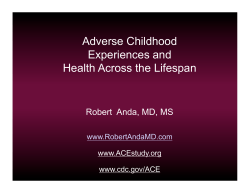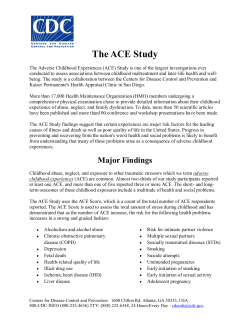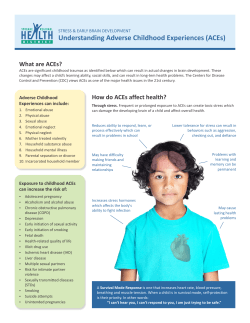
Adverse Childhood Experiences: Robert Anda, MD, MS Connecting a Developmental Lens
Adverse Childhood Experiences: Connecting a Developmental Lens to the Health of Society Robert Anda, MD, MS ACE Study Concepts www.RobertAndaMD.com www.acestudy.org www.cdc.gov/ace The Walk to Paradise Garden W. Eugene Smith Stress (adrenaline, cortisol) Unpredictable Severe Predictable Moderate Number of Episodes Chronicity* Vulnerability (Poly)genetics Epigenetics Intrauterine exposures* Resilience Barriers to Educational Achievement Emerge at a Very Young Age Cumulative Vocabulary (Words) 1200 1000 College Educated Parents 800 600 Working Class Parents Welfare Parents 400 200 16 mos. 24 mos. 36 mos. Child’s Age (Months) Source: Hart & Risley (1995) “The Creation of Adam” Michelangelo 1508-1512 The Adverse Childhood Experiences (ACE) Study Examines the health and social effects of ACEs throughout the lifespan among 17,421 members of the Kaiser Health Plan in San Diego County A Primary Care Setting… Educated… Middle Class.. Predominantly White… ACE Study Design Survey Wave I (N=9,508) Survey Wave II (N=8,667) Mortality National Death Index Follow-up Morbidity Hospital Discharge N = 17,421 Outpatient Visits Emergency room visits Pharmacy Utilization Comprehensive medical Evaluations abstracted Adverse Childhood Experiences Are Common Household dysfunction: Substance abuse Parental sep/divorce Mental illness Battered mother Criminal behavior 27% 23% 17% 13% 6% Abuse: Psychological Physical Sexual 11% 28% 21% Neglect: Emotional Physical 15% 10% Adverse Childhood Experiences Rarely Occur in Isolation… They come in groups. Alcohol Abuse in the Home and the Risk of Other ACEs... Alcohol Abuse in the Home and the Risk of Childhood Abuse 50 45 Number of alcohol abusers: 0 Percent Abused (%) 40 1 2 or more 35 30 25 20 15 10 5 0 Emotional Physical Type of Abuse Sexual Domestic Violence in the Home and the Risk of Other ACEs... Prevalence of Childhood Abuse by Frequency of Witnessing Domestic Violence 100 Frequency of witnessing domestic violence Never Once,Twice Sometimes Often Very often Percent (%) 80 60 40 20 0 Emotional Physical Childhood Abuse Sexual ACEs tend to come in groups… Additional ACEs (%) 1 2 3 4 >5 If you had: A battered mother 95 82 64 48 52 Adverse Childhood Experiences Score Biologic Stress “Dose” ACE Score 0 1 2 3 4 or more Prevalence 33% 26% 16% 10% 16% ACEs, Smoking, and Lung Disease Percent With Health Problem (%) 20 ACE Score 18 0 1 2 3 4 or more 16 14 12 10 8 6 4 2 0 Early smoking initiation Current smoking COPD The ACE Score… Alcohol Use and Abuse 40 ACE Score Percent with alcohol related problem 35 0 1 2 3 4 or more 30 25 20 15 10 5 0 Ever heavy drinker Problem with alcohol use Alcoholic Married an Alcoholic ACE Score and HIV Risks 20 Percent With Health Problem (%) 18 16 14 ACE Score 0 1 2 3 4 or more 12 10 8 6 4 2 0 Ever Injected Drugs Had 50 or More Intercourse Partners Ever Had an STD The ACE Score and the Prevalence of Liver Disease (Hepatitis/Jaundice) 12 Percent (%) 10 8 6 4 2 0 0 1 2 ACE Score 3 >=4 The ACE Score and the Prevalence of Coronary Heart Disease 6 Percent (%) 5 4 3 2 1 0 0 1 2 ACE Score 3 >=4 A Focus on Mental Health… The ACE Score and a Lifetime History of Depression Percent depressed (%) 70 Women Men 60 50 40 30 20 10 0 0 1 2 ACE Score 3 >=4 Percent atempted (%) The ACE Score and the Prevalence of Attempted Suicide 20 15 10 5 0 0 1 2 ACE Score 3 >=4 Cumulative ACEs Increase the Number of Lifetime DSM-IV Diagnoses* National Comorbidity Survey – Replication Sample 9 N=5692 Number of Lifetime DSM-IV Diagnoses 8 7 6 5 4 3 2 1 0 *Putnam, Harris, Putnam unpublished data, 2011 CCAP0 CCAP1 CCAP2 Increasing ACEs CCAP3 CCAP4 Art of: Hieronymous Bosch “The Kiss” Constantin Brancusi 1909 ACE Score and the Risk of Being a Victim of Domestic Violence Women 15 Men 10 5 0 0 1 2 3 4 >5 0 ACE Score 1 2 3 4 >5 ACE Score and the Risk of Being Sexually Assaulted as an Adult 40 Women Men 30 20 10 0 0 >5 1 2 3 0 4 ACE Score 1 2 3 4 >5 ACEs and Reproductive Behavior …. Are they self replicating?? ACE Score and Teen Sexual Behaviors Percent With Health Problem (%) 45 40 0 ACE Score 1 2 3 4 or more 35 30 25 20 15 10 5 0 Intercourse by Age 14 Teen Pregnancy Teen Paternity Relationship Between Number of Adverse Childhood Experiences and Adolescent Pregnancy 60 50 40 30 20 10 0 0 1 2 3 4 ACE Score 5 6 7-8 Percent of Women Who Ever Had an Unintended Pregnancy by ACE Score 80 70 Percent 60 50 40 30 20 10 0 0 1 2 ACE Score 3 4 or more Relationship Between Number of Adverse Childhood Experiences and Fetal Death—First or Second Pregnancy 18 16 14 12 10 8 6 4 2 0 0 1-2 ACE Score 3-4 5+ Watercolor By Tennessee Dixon @ 1978 Estimates of the Population Attributable Risk* (PAR) of ACEs for Selected Outcomes in Women Mental Health: Current depression Depressed affect Suicide attempt Drug Abuse: Alcoholism Drug abuse IV drug abuse PAR 54% 41% 58% Promiscuity 48% Crime Victim: Sexual assault Domestic violence 62% 52% 65% 50% 78% *Based upon the prevalence of one or more ACEs (62%) and the adjusted odds ratio >1 ACE. ACEs Changed the Landscape • Provided a compelling tabulation of childhood adversity that directly related to easily understood costly outcomes • Largely responsible for increased awareness of policy makers of the role of childhood trauma in costly medical, psychiatric and social problems • Legitimized and stimulated interest in childhood adversities for researchers in a range of fields ACEs Changed the Landscape • Pervasiveness of ACEs – Huge number of major public health problems that were ACE-related (e.g., Depression, Substance Abuse, STDs, Cancer, Heart Disease, Chronic Lung Disease, Diabetes) – Significant number of middle-class Americans had ACEs • Perniciousness of ACEs – Major contributors to the leading causes of death and disability – Life-shortening (~20 years for people with 6+ ACEs) • Persistence of ACEs – Life-time effects – Likelihood of intergenerational transmission Beyond ACEs • Link ACEs to existing and future programs seeking to prevent mental illness, medical diseases, substance abuse, health risk behaviors, and social dysfunction • Prevent ACEs – Zero ACEs is protective – Prevent further ACEs in maltreatment victims • Identify and treat ACEs early in life • Identify mechanisms (behavioral and biological) through which ACEs negatively impact life trajectories The Walk to Paradise Garden W. Eugene Smith The Costs of the Status Quo.. Reflect the Costs of Ignoring and Impairing Early Childhood Development ACEs and High School Sophomores and Seniors Population Average Spokane Washington Students with 3 or more ACEs: ·Are 2 ½ times more likely to fail a grade ·Score lower on standardized tests ·Have language difficulties ·Are suspended or expelled more ·Are designated to special education more frequently -Have poorer health Courtesy of Chris Blodgett, PhD Washington State University Costs of the Status Quo Criminal Justice ..the prison pipeline ACEs Among Youth on Probation Pierce County, Washington Tacoma Urban Network ACE Exposure and Youth Outcomes History of Alcohol & Drug Use and ACE Score 100% 80% 60% 63% 68% 71% 77% 74% 80% 72% 74% 81% 84% 50% 54% 40% 20% 0% 0 1 2 Alcohol 3 Drug 4 ≥5 ACE Score and Repeated Suspension/Expulsion Youth on Probation, Pierce County, WA History of > 7 expulsions or suspensions since the first grade 50 10 30 1 20 10 16.9% (n=11) 25.5% (n=69) 35.3% (n=158) 35.7% (n=148) 38.6% (n=124) 39.4% (n=148) 0 0.1 0 1 2 3 ACE Score 4 5+ aOR (95% CI) Prevalence (%) 40 ACE Score and Poor Academic Performance Youth on Probation, Pierce County, WA Poor academic performance during most recent school term 50 10 30 1 20 10 16.9% (n=11) 25.0% (n=68) 29.1% (n=132) 28.1% (n=117) 32.3% (n=105) 35.7% (n=135) 0 0.1 0 1 2 3 ACE Score 4 5+ aOR (95% CI) Prevalence (%) 40 Tacoma Urban Network ACE Score and Felony Re-offense Felony Re-offense Post Probation and ACE Score 40% 31% 30% 25% 25% 20% 18% 16% 12% 20% 16% 23% 19% 11% 10% 10% 0% 0 1 2 Within One Year 3 4 Within Two Years ≥5 Costs of the Status Quo Health Care Prescription Drugs in the United States (2003) -nearly $180 billion spent -11% of total national health expenditures -more than four times the amount spent in 1990 Prescription rate (per 100 person-years) ACE Score and Rates of Antidepressant Prescriptions 100 90 80 70 60 50 40 30 20 10 0 0 1 2 3 ACE Score 4 >=5 Costs of the Status Quo Corporations and the Workforce Drains on Profitability.. Depression and its work related outcomes, absenteeism, reduced productivity, and medical expenses: $44 billion per year Back pain in the workforce: $28 billion per year Chemical dependency: $246 billion per year These massive losses occur despite the existence of workplace safety programs and the most expensive system of medical care in the world. [ ACE Score and Indicators of Impaired Worker Performance 25 ACE Score 20 0 1 2 3 4 or more 15 10 5 0 Absenteeism (>2 days/month) Serious Financial Problems Serious Job Problems 4 Areas of Health and Well-Being as Mediators Adverse Childhood Experiences Relationship Problems -marital -family -sexual Emotional Distress -depressed mood -panic reactions -difficulty with anger Somatic Symptoms -back pain -headaches -joint problems Substance Abuse -alcoholism -smoking -illicit drug use Poor Worker Performance ―In the brain, as in the economy, getting it right the first time is ultimately more effective and less costly than trying to fix it later. ― James Heckman Nobel Laureate Economist National Scientific Council on the Developing Child, Perspectives: The Cradle of Prosperity. (2006). http://www.developingchild.net ACEs Effect An Array of Brain Functions Affect Regulation Panic reactions, depression, anxiety, hallucinations Somatic Issues Sleep disturbances, severe obesity, pain Substance Use Smoking, alcoholism, illicit drug use, IV drug use Sexuality Early intercourse, promiscuity, sexual dissatisfaction Memory Amnesia (childhood) Arousal High stress, problems with anger, perpetrating domestic violence Neurobiology and Epidemiology Converge Complex Trauma—Trauma Spectrum Disorders and the mean number of a variety of problems Mean Number of Co-occurring Outcomes 6 5 4 3 2 1 0 0 1 2 3 4 5 ACE Score * 6 7-8 ACEs appear to affect multiple brain systems and functions. This leads to multiple problems in different health and social domains. Developmental Trauma Disorder Adverse Childhood Experiences As a National Health Issue ACEs have a strong influence on: -adolescent health -reproductive health -smoking -obesity -alcohol abuse -illicit drug abuse -sexual behavior -mental health - risk of violence and revictimization -stability of relationships -performance in the workforce Adverse Childhood Experiences As a National Health Issue ACEs increase the risk of: -Early death -Heart disease - Chronic Lung disease -Lung cancer - Liver disease -Autoimmune disease - Suicide - Injuries -HIV and STDs - other risks for leading causes of death Beham, (Hans) Sebald (1500-1550): Hercules slaying the Hydra, 1545 from The Labours of Hercules (1542-1548). A Public Health Framework For Change Treatment Education Prevention All must consider Intergenerational transmission Bridging The Chasm Child health as it stands today Intergenerational Care Consolidation and Coordination Child and adult health as it could be Bridging The Chasm Child health as it stands today Breakthroughs in molecular genetics and neurobiology: Mental illness Substance abuse Violence Improved recognition and treatment of: Mental illness Substance abuse Domestic violence Child abuse Child health as it could be Bridging The Chasm Child health as it stands today Mass education about child development & parenting: Media Schools Promoting Healthy Neurodevelopment through better early childhood development (Promoting Resilience) Child health as it could be Bridging The Chasm Child health as it stands today Harnessing Brain Plasticity To Overcome the Effects of Adversity (Resilience or Recovery) Documenting the societal burden of child health as it stands today New directions in prevention, treatment, and policy Child health as it could be Limits of Understanding by Paul Klee (1879-1940) ..the prison pipeline extends into adulthood ACE Scores Kaiser Health Plan 35 30 Percent (%) 25 20 15 10 5 0 0 1 2 3 ACE Score 4 >=5 Messina and Greila Am J Pub Health October, 2006 ACE Scores Kaiser vs Adult Women In Prison 35 30 Percent (%) 25 20 15 10 5 0 0 1 2 3 ACE Score 4 >=5 Messina and Greila Am J Pub Health October, 2006 These Mediators Account for Most of the Effect of ACEs on Worker Performance Indicators of Worker Performance % Mediation by 4 Areas of Health and Well-Being Absenteeism 50-67% Serious Financial Problems 50-83% Serious Job Problems 79-100% Public Health Surveillance Information for Program Applications Data Interpretation Data Analysis Program Evaluation Information Dissemination Data Collection Source: Remington and Goodman 1998 Program Implementation Program Planning States With ACE Studies in 2008 No data Source: Behavioral Risk Factor Surveillance System, CDC. States With ACE Studies in 2009 6 States No data 2009 Source: Behavioral Risk Factor Surveillance System, CDC. States With ACE Studies in 2009-2010 13 States No data 2009 2010 Source: Behavioral Risk Factor Surveillance System, CDC. States With ACE Studies in 2009-2011 18 States No data 2009 2010 2011 Source: Behavioral Risk Factor Surveillance System, CDC. ACEs: A Global Challenge Costs of the Status Quo Health Care Corporations and the Workforce Criminal Justice ADVERSE CHILDHOOD EXPERIENCE • Slowed language & reading • Lateralization • Diminished IQ • Poor decision making skills • Attention problems • ADD • ADHD • Aggressive behavior • Social isolation among peers • Poor understanding of social cues = conflict Significant risk of early use/abuse of: Alcohol, tobacco, illicit & prescription drugs Predictable patterns of brain development, traits & behaviors EARLY TRAUMA & STRESS THE FAST TRACK TO POVERTY • Special education • School failure • Dropping out • Low-wage jobs • Unemployment • Public Assistance • Prison • Suspension • Expulsion • Delinquency • Dropping out • Chronic health problems • Debilitating mental health The brain’s activity can be measured in electrical impulses—here, ―hot‖ colors like red or orange indicate more activity, and each column shows a different kind of brain activity. Young children institutionalized in poor conditions show much less than the expected activity. Preventive Intervention is More Efficient and Produces Higher Returns than Later Remediation Programs targeting the earliest years Rates of return to human capital investment Preschool programs K-12 interventions Job training 0-3 4-5 6-18 Age 19+ Heckman, J. (2007)
© Copyright 2025





















